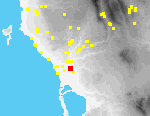 I03 Koryfasio Portes
I03 Koryfasio Portes
The site of Portes is located on a very low rise, bisected by the Pylos-Hora asphalt road, ca. 200 m. SW of the outskirts of the modern town of Koryfasio.[096.16][114.21] Much of the area of the site is planted with older olives and vines.
The site was found by Kourouniotis who showed it to Blegen; McDonald and Hope Simpson first described it in detail. Since then, Portes has been greatly modified and is in danger of being completely destroyed. There is a tile factory at its northern edge and bulldozers have recently levelled parts of the site, both E and W of the road. Soil has also been brought from elsewhere and spread on some of the fields that comprise the site.
McDonald and Hope Simpson found many sherds on the E side of the road, particularly in its E bank; they found almost no artifacts W of the road. The owner of the property told them that many stone blocks had been removed from the site and that others remained beneath the surface. [Indeed the area is today called "Marmara" by locals.] Among pottery collected by them was LH, but no certain pre-Mycenaean pottery, and a few C and HL black-glazed sherds. They also recorded an extraordinarily large number of obsidian, chert, and ground stone tools, many in an unfinished condition, and suggested on this basis that stone tools were manufactured at the site.
Our own investigations have partly confirmed McDonald and Hope Simpson's observations. Prehistoric pottery was in 1994 and 1995 most common to the E of the asphalt road and adjacent to it, immediately N and S of a dirt track [096.15]that runs to the E; the ground there around a large olive tree is slightly higher than elsewhere, and traces of a possible wall can be discerned in the bank of the road, ca. a meter beneath ground level. Prehistoric pottery was also found in smaller quantities farther north on the E side of the road and on its W side. Pottery of the historical periods was in small quantities more widely distributed. We did not, however, find an extraordinary number of lithic artifacts nor did we observe cut blocks.
The site yielded diagnostic late MH-LH IIIB material. There is also a small amount of Historical material, most not very precisely datable. Early Modern-Modern pottery occurs throughout the site.